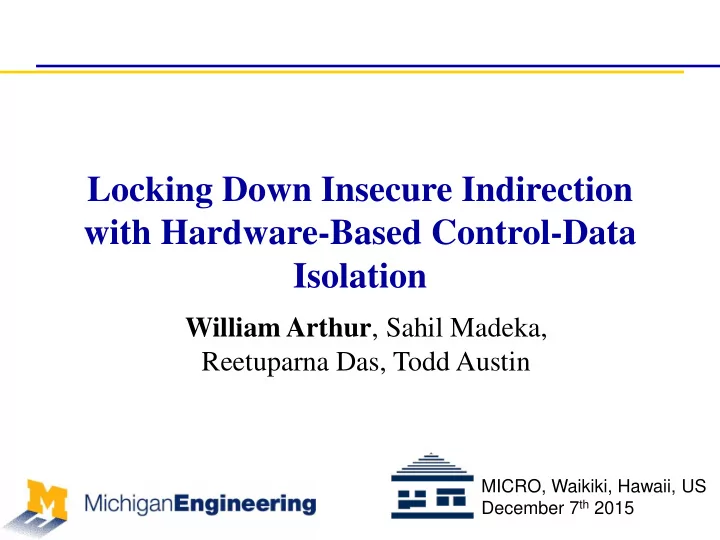

Locking Down Insecure Indirection with Hardware-Based Control-Data Isolation William Arthur , Sahil Madeka, Reetuparna Das, Todd Austin MICRO, Waikiki, Hawaii, US December 7 th 2015
Goal of this work MAKE SOFTWARE MORE SECURE Reducing the software attack surface by subtracting the root cause leading to many software exploits today Accomplished by locking down insecure indirection 2
Locking Down Insecure Indirection (1) Every control transfer in executing application comes from the programmer: Every PC address encoded in instructions, OR Is derived from secure hardware structures Executing application always adheres to the programmer-defined control-flow graph Stopping control-flow attacks which derail the CFG 3
Locking Down Insecure Indirection (2) Achieved by hardware-software co-design Software: Eliminate all indirect control-flow instructions – via Control-Data Isolation (CDI) [1] Hardware: Memoization of secure control transitions in secure hardware – via Indirect Edge Cache [1] Getting in Control of Your Control Flow with Control-Data Isolation , Arthur et al., CGO 2015 4
Outline Software (in)security – Control-Flow Attack Software (in)security Hardware-Based Control-Data Isolation Hardware-Based Control-Data Isolation Measure performance and security Measure performance and security Conclusions Conclusions 5
Control-Flow Attack Control-Flow Attacks violate, at runtime, the CFG of an application by corrupting the PC with user-injected data return ????? Buffer Overflow local variables, return Heap Spray attack value Return-to-libc code Code Gadgets Stack Smash buffer 6
Outline Software (in)security Hardware-Based Control-Data Isolation Measure performance and security Conclusions 7
Control-Data Isolation int bar() { int bar() { int bar() { // function code // function code // function code return; if ([%esp]==_ret1) } jump _ret1; return; Vulnerable Code else if ([%esp]==_ret2) } jump _ret1; ret Vulnerable Code else call _abort; } White-list of valid “ Sled ” of conditional branches CFG edges and direct jumps 9
Hardware-Based CDI Software- only CDI (CGO ’15) retains higher than desired runtime overheads for some applications – 31% for gcc Key insight: Caching previously executed sled edges obviates subsequent re- executions of the sled Addition of hardware edge cache 11
Hardware-Based CDI Algorithm Indirect Instruction Execute (*jmp, *call, ret) Instructions Hit? Check Edge Cache Cache for <source,target> <source,target> of taken branch pair Miss? Fall-through to sled , retain Taken branch <source> from sled 12
Hardware-Based CDI Algorithm Indirect Instruction Execute (jmp, call, ret) Instructions Hit? Check Edge Cache Cache for <source,target> <source,target> of taken branch pair Miss? Fall-through to sled , retain Taken branch <source> from sled 13
Hardware-Based CDI Algorithm Indirect Instruction Execute (*jmp, *call, ret) Instructions Hit? Check Edge Cache Cache for <source,target> <source,target> of taken branch pair Miss? Fall-through to sled, retain Taken branch <source> from sled 14
Hardware-Based CDI Algorithm Indirect Instruction Execute (jmp, call, ret) Instructions Hit? Check Edge Cache Cache for <source,target> <source,target> of taken branch pair Miss? Fall-through to sled , retain Taken branch <source> from sled 15
Hardware-Based CDI Algorithm Indirect Instruction Execute (jmp, call, ret) Instructions Hit? Check Edge Cache Cache for <source,target> <source,target> of taken branch pair Miss? Fall-through to sled , retain Taken branch <source> from sled 16
Hardware-Based CDI Algorithm Indirect Instruction Execute (jmp, call, ret) Instructions Hit? Check Edge Cache Cache for <source,target> <source,target> of taken branch pair Miss? Fall-through to sled, retain Taken branch <source> from sled 17
Hardware-Based CDI Algorithm Indirect Instruction Execute (jmp, call, ret) Instructions Hit? Check Edge Place Cache for <source,target> in the Edge <source,target> Cache pair Miss? Fall-through to sled, retain Taken branch <source> from sled 18
Hardware-Based CDI Algorithm Indirect Instruction Execute (jmp, call, ret) Instructions Hit? Check Edge Cache Cache for <source,target> <source,target> of taken branch pair Miss? Fall-through to sled, retain Taken branch <source> from sled 19
Hardware-Based CDI Algorithm Indirect Instruction Execute (*jmp, *call, ret) Instructions Hit? Check Edge Cache Cache for <source,target> <source,target> of taken branch pair Miss? Fall-through to sled, retain Taken branch <source> from sled 20
Hardware-Based CDI Algorithm Indirect Instruction Execute (jmp, call, ret) Instructions Hit? Check Edge Cache Cache for <source,target> <source,target> of taken branch pair Miss? Fall-through to sled , retain Taken branch <source> from sled 21
Edge Cache(1) New hardware structure – edge cache Memoization of most recent indirect edges 22
Edge Cache(2) Fetch Edge Cache Squash, execute <src,target> sled Commit No = Retire Yes 23
Edge Cache(2) PC BTB Fetch Target Edge Index Cache Squash, GHR execute <src,target> sled Commit No = Retire Yes 24
Challenges Edge Cache Source Target U V Address Address tag, full address 128 + 2 bits per entry! 1k entries = 16 kB 26
Region Table Edge Cache Source Target Region Region G G U V Addr. Offset Addr. Offset Pointer(S) Pointer(T) offset, 18 bits index, 5 bits 27
Region Table Edge Cache Source Target Region Region G G U V Addr. Offset Addr. Offset Pointer(S) Pointer(T) Region Table Region Address G U V 28
Region Table Edge Cache Source Target Region Region G G U V Addr. Offset Addr. Offset Pointer(S) Pointer(T) 50 bits per Region Table entry! Region Address G U V 1k entries 6.75 kB total Region Offset full address 29
Outline Software (in)security Hardware-Based Control-Data Isolation Measure performance and security Conclusions 30
Experimental Setup gem5 architectural simulator Detailed O3 cpu model, configured similar to Intel Haswell processor, x86-64 SPECINT 2000 & 2006 1,024-entry edge cache 4-way set associative 32-entry region table 31
Speedup Over Native Execution 1.2 0.995 Hardware-Based CDI Software-Based CDI 1 0.8 0.84 0.6 0.4 0.2 0 Benchmark Applications Branch prediction – 6% speedup 400.perlbench vs BTB 32
Security Average Indirect target Reduction – AIR [2] Measure of the reduction in the software attack surface 99.999%+ reduction in indirect target set Average of tens of targets per indirect Previous works : average of tens of thousands of targets per indirect instruction [2] Control Flow Integrity for COTS Binaries , Zhang and Sekar, USENIX Security 2013 33
Conclusions Locking down insecure indirection can eliminate contemporary control-flow attacks Hardware-based control-data isolation efficiently realizes this capability Minimal runtime overhead – 0 . 5% 34
Thank You Questions? 35
Recommend
More recommend